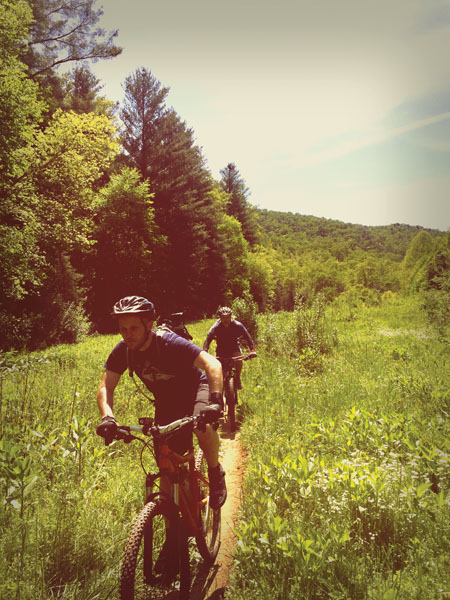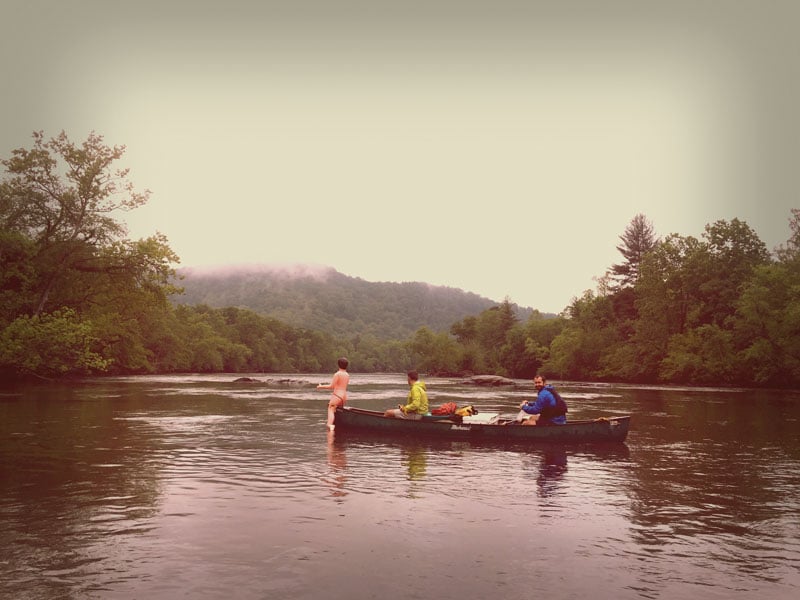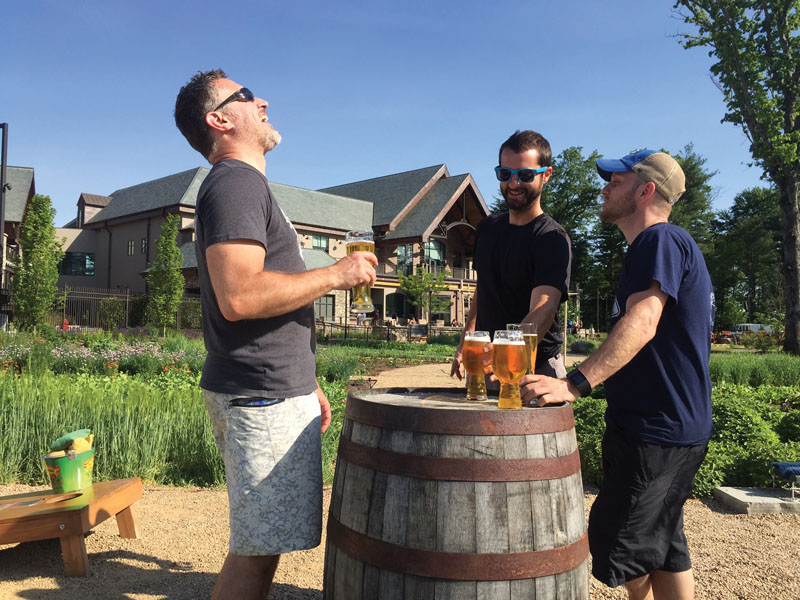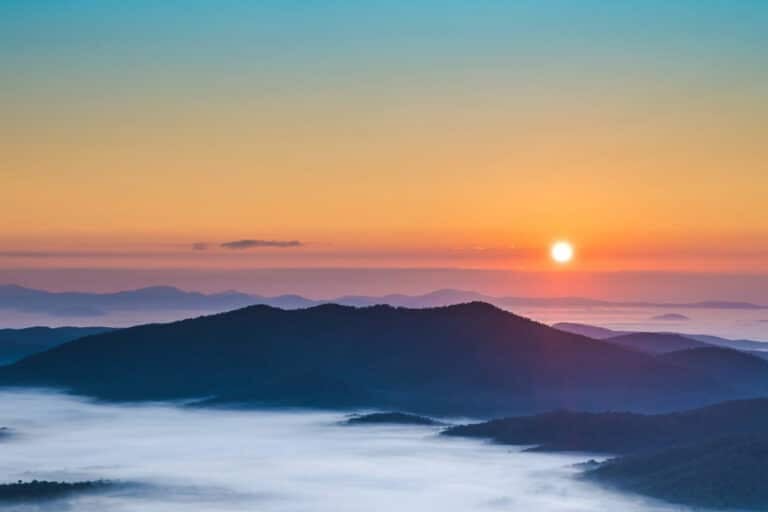The thing about Will Smith, the rapper and actor, is you either love him or you hate him. There can be no middle ground. At least that’s what I’m learning as we huddle around my broken chain in the middle of Pisgah National Forest. I was in the wrong gear and tried to power up the steep, dirt road climb that leads to Spencer Branch, a recently re-designed downhill that drops off the Blue Ridge Parkway above Mills River. Pisgah is best known for its super tech, rutted out fall line trails that were built by the CCC eons ago, but Spencer is something different. A bit of purpose-designed flow in the heart of the East’s oldest national forest. Obviously, I was too eager to get to Spencer and my chain snapped before I could even settle into the climb. Now, all four of us are trying to repair the chain without losing that little pin that keeps two links together. But mostly, we’re debating the merits of Will Smith.
Everyone seems to agree Mr. Smith is a fine actor, but his rapping prowess is debatable.
The trip we’re on is a thing of beauty. A perfect three-day loop connecting three world-class breweries by mountain bike and canoe. Here’s how you do it: First, pedal singletrack and gravel roads through Pisgah from Asheville to Oskar Blues in Brevard. Drink and camp. Then, trade the bikes for canoes and paddle to Sierra Nevada. Drink and camp. Complete the loop by paddling back to Asheville and hit the newly opened New Belgium taproom, which hangs over the French Broad River just outside of downtown. Three days, three world-class breweries, camping, singletrack and class I paddling along the French Broad. Like I said, a thing of beauty.

But we’re only a couple of hours into this epic adventure and my bike is falling apart and there’s a growing divide amongst the crew—a chasm is forming around Will Smith.
Hartwell Carson, the French Broad River Keeper, sings a couple of lines from “Miami.”
Jeff Keener, a board member for Pisgah SORBA, shakes his head and declares the song to be “ridiculous.”
After hearing Hartwell’s rendition of “Miami,” the fourth member of our crew, Jeremiah LeRoy, seems to be siding with Keener. Personally, I’m indifferent about Mr. Smith. I just don’t want to have to push my bike 40 miles across Pisgah National Forest.
God Likes Me
Some of the West’s largest craft breweries started building East Coast operations several years ago to capitalize on the East’s thirsty population base. Three of those breweries, Oskar Blues, Sierra Nevada, and New Belgium, which together make some of the best beers in the world, happened to build their new facilities close to my home town of Asheville. I think they did this because God likes me. Look at the new breweries on a map and they form a kind of triangle of goodness surrounding Pisgah National Forest and the French Broad. Technically, you could drive to these breweries, but with a little bit of logistics, you could turn a standard brewery tour into a multi-sport adventure.
The first couple of hours are uneventful as we climb out of Bent Creek Experimental Forest on the edge of Asheville on a long, steep gravel road, riding through a dark tunnel splattered with graffiti beneath the Blue Ridge Parkway. The flow of Spencer comes shortly after fixing my chain. The trail drops through stands of skinny hardwoods for two miles—a perfect bench cut path hugging the edge of the slope offering the occasional ballsy B-line drop and a big sweeping berm with every change of direction. Rock gardens are scattered throughout to keep things interesting, but for the most part, it’s a carefree descent. This sort of flow is relatively new to Pisgah, and some bikers complain that it’s part of the greater “dumbing down” of the forest. It’s not hard enough. Not technical enough. None of us complain as we carry speed through the berms and rocks, all smiles as we hit the last kicker where the trail meets the gravel road.
There’s more carefree singletrack through big, grassy meadows on Fletcher Creek and then we’re crossing creeks and pushing up a steep, rutted out trail in search of a shortcut to cut off some gravel road. There’s no avoiding the big climb of the day, though—a gravel grinder along Forest Road 1206 up to Yellow Gap. We settle into a manageable pace and start discussing the shortcomings of the current health insurance industry, because we’re old, and soon we hit Yellow Gap, where we snack on beef jerky and a can of Pringles.
It’s sunny, not too hot, we’ve been riding our bikes since 9 a.m. and we’re eating heavily smoked beef. All things considered, that’s a pretty good day. We haven’t even had a brush with death yet. That won’t happen until we hit Avery Creek at the end of the day.
If Spencer Branch is “new Pisgah,” then Avery Creek is “old Pisgah.” It’s basically a dry creek bed that drops down the fall line of the mountain, carving a deep, red-clay ditch into the slope that’s riddled with massive root gardens, Yeti Cooler-sized boulders and the occasional tree. In other words, it’s awesome, and I’m eating it up, going faster than I should be, until I see Jeremiah fly through the air, head first into a skinny tree. He grazes off the hardwood and lands with his face in the dirt, his bike on top of him like a blanket. A really painful blanket.
His legs are bleeding and there’s a golf-ball sized knot forming on his shin, but otherwise, he’s good. No brain damage. No broken collar bone. We give him a few minutes, do a quick concussion test and then we’re riding again, hurrying now because we have to make it to Oskar Blues before they close. We pop out of the forest on Highway 276 and hop on a greenway that will take us straight to the brewery, sprinting in our heaviest gear and passing old couples on cruisers, yelling “on your left!” as we fly by them.
Oskar Blues is a fairly industrial affair with a concrete beer garden and a small taproom overlooking the brewery. The beers are cold and we order two burgers each before pedaling to our first campsite, tucked into a large farm on the edge of the French Broad.
Hartwell has stashed our canoes and his truck at the campsite (logistics!), so we take his truck to scavenge the farm for firewood, listening to country music as we cruise through the pastures. We find a bunch of dry pallets and erect a bonfire so large, you could land a plane by it, and complain about eating too many burgers until we start peeling off for our tents.
The Baby Squirrel Conspiracy
In theory, the 44 miles we biked across Pisgah National Forest should be the toughest leg of this multi-day, multi-sport adventure, but we have 28 miles to paddle from the campsite to Sierra Nevada in sluggish canoes loaded down with beer and gear. I figure we have a 50/50 shot of getting to the brewery before dark, and there are a number of things that could derail our efforts. Thunderstorms, low water, pirates…but honestly, if we don’t make it to Sierra Nevada in time it’ll probably be because of the 30 minute argument we have over Keener’s baby squirrel theory. Here’s the gist of the theory: there is no such thing as baby squirrels.
“Nobody’s ever seen a baby squirrel,” he says, sipping his coffee. “They don’t exist. Seriously, have you ever seen a baby squirrel?”
“Well, no, but…” Jeremiah says.
“That’s because they don’t exist. I’ve even looked for them on the internet. I can’t find any pictures.”
“So where do adult squirrels come from?”
“I don’t know,” Keener says. “All I know is that there are no baby squirrels.”
“So wait,” Hartwell says. “You’re saying baby squirrels don’t exist because nobody you know has ever seen one, and you’ve done a Google image search?”
The conversation goes on like this for far too long, until Jeremiah finds a picture of a baby squirrel on his phone for Keener to study. It’s one of the greatest uses of the iPhone in the history of the internet.
The section of the French Broad between Brevard and Mills River, where Sierra Nevada sits, rolls through farm country. Bluffs, rising 20 feet from the water, frame the river, giving way to sprawling pastures on either side. Off in the hazy distance, the farms are hemmed in by subtle, low-rising green mountains. Occasionally, we’ll pass an ostentatious trophy home, with perfect grass rolling down to the river, but mostly, the scene is pastoral. It’s all very “Southern” in a way, and it makes me wish I had a bigger drawl, at least for this portion of the trip.
Paddling is slow work, so we pass the time mostly by drinking beer and creating segments on Strava to see which boat is the fastest. Jeremiah and I are in one canoe and Keener and Hartwell are in the other. Each canoe has a giant cooler in the center, with camping gear in dry bags packed around it. According to Strava, neither boat is fast.
Eight hours later, our boats are beached and we’re playing bocce next to Sierra Nevada’s organic garden. If craft beer has a Xanadu, it’s Sierra Nevada’s new Mills River brewery. The building is a massive blend of river stone and copper finishes, and the expansive grounds are highlighted with large gas fire-pits, perfect grass and lawn game zones. We play bocce, throwing heavy balls at each other in the sand, and drink beer from fancy glasses, laughing about the fact that we rode our bikes and paddled canoes here.
Dinner is an affair of lamb, tartare and mussels—a far cry from the food truck burgers we ate the night before. After asking for the dish that “has the most amount of calories for the least amount of money,” Hartwell tries to negotiate with the waitress for the price of a chocolate brownie. The brownie costs $9. Hartwell is willing to pay $3. The waitress is an excellent negotiator and Hartwell pays $9.
Our campsite is a mile upstream from Sierra Nevada, and we paddle it slowly in the dark, trying to feel our way through patches of shoals. It’s like reading braille. We set up our tents by headlamp and climb in just in time to beat an all-night thunderstorm, falling asleep to the rain beating down on our tents.
Saving Cinnamon
The rain continues through the morning as we pack up our wet tents and start paddling north, moving through a more industrial stretch of the French Broad that runs along Interstate 26. In the midst of a heavy downpour, we contemplate beaching the canoes and climbing the slope to have breakfast at Waffle House. After an hour of paddling through the storm, the rain stops, the sun comes out and the most amazing thing happens: we find a fully inflated blow up doll. The kind you get at those truck stop sex shops. Or so I’ve heard. When you find a sex doll lying on a rock on the edge of the river beneath a highway overpass, you have to rescue it. You have to strap it to the bow of your canoe like one of those figureheads from ancient ships and give it a name.
When you find a sex doll lying on a rock on the edge of the river beneath a highway overpass, you have to rescue it. You have to strap it to the bow of your canoe like one of those figureheads from ancient ships and give it a name.
“It should be something French and classy,” Jeremiah says.
“Like Cinnamon?” Hartwell says.
We paddle with Cinnamon on the bow of Hartwell’s boat for the next 10 miles, passing through the Biltmore’s extensive grounds where families ride cruiser bikes and play Frisbee along the greenway next to the river. Some of them laugh and wave, others shield their children’s eyes from the sight of a blow up doll paddling in a canoe.
New Belgium’s new brewery and taproom is our final stop. The taproom is small compared to Sierra Nevada’s Disneyland-like extravagance, but it’s beautiful in an industrial/modern sort of way, with a retractable glass wall leading onto a broad deck overlooking the river. As we paddle beneath the taproom, people start lining the railing of the deck, waving at us and taking pictures. A few of them clap and whistle. Everyone is smiling. I know they’re clapping for Cinnamon, the discarded sex doll who’s found a new home as our canoe’s figurehead, but I like to think a small part of the ovation is for our achievement in multi-sport innovation. Three days, three breweries, three sports (if you consider drinking a sport). An 88-mile loop by singletrack and river, all human powered.
Like I said, a thing of beauty.







